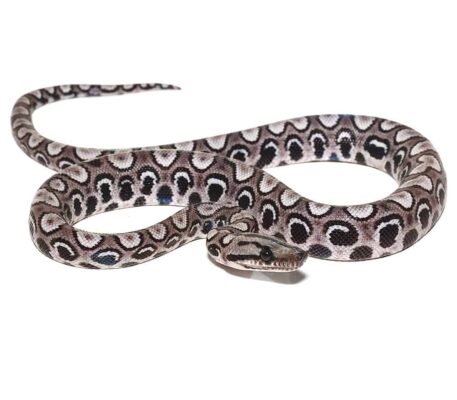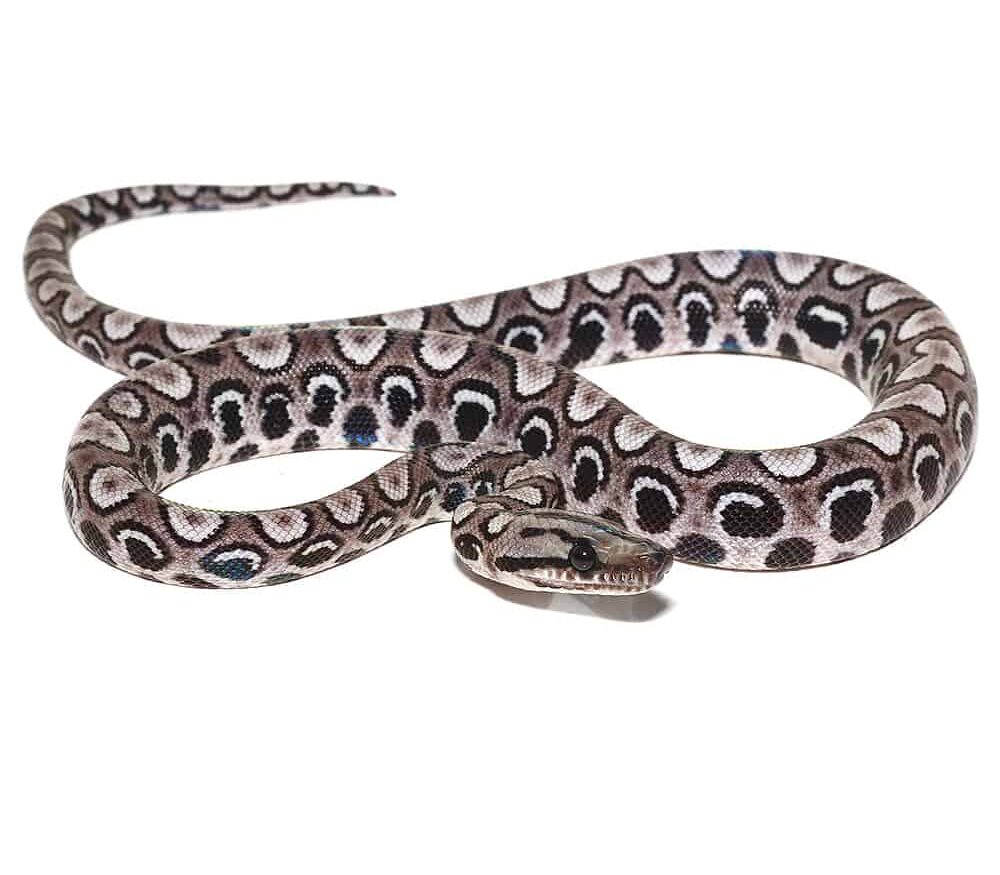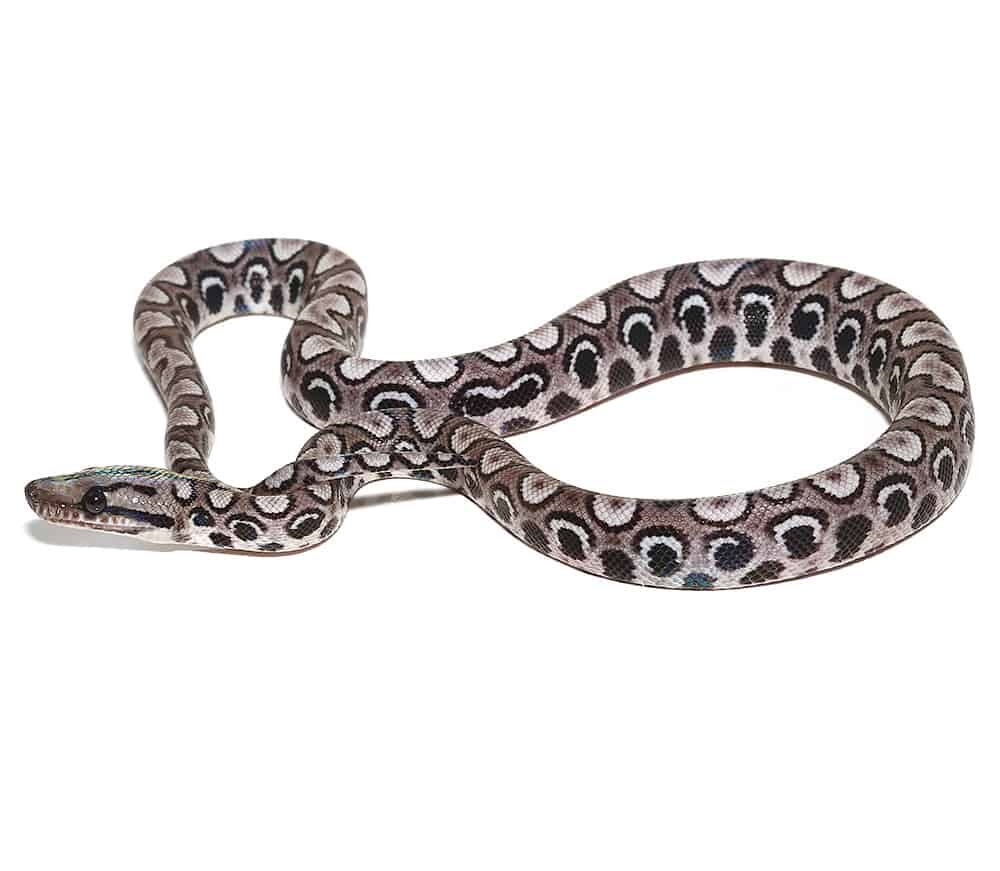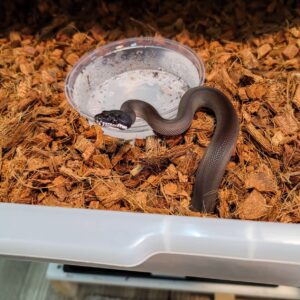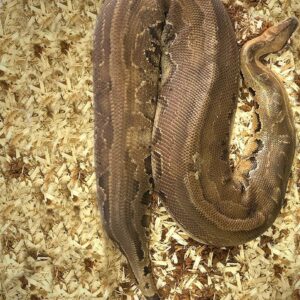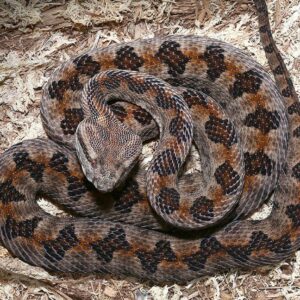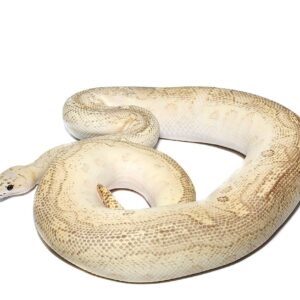Baby Black Anery Brazilian Rainbow Boa For Sale
$999.99
WE HAVE A BABY BLACK ANERY BRAZILIAN RAINBOW BOA FOR SALE. HERE ARE SOME HIGHLIGHTS:
- Epicrates cenchria
- Captive Bred
- Approximately 20-21 Inches In Length From Head To Tail
- Roughly 40 Grams And Growing
- Adults Can Reach Up To 6-7 Feet In Total Length
- Feeding On Live And Frozen Thawed Fuzzy Mice Weekly
FUN FACTS!
- These Snakes Get Their Names From Their Iridescent Scales That Make Them Shimmer In The Sun
- Anery Is The Lack Of Red Pigment In This Beautiful Snake
- Tropical Species That Requires High Humidity, Add Sphagnum Moss To Their Substrate
- This Boa Comes From South America In The Amazon Basin Ranging From Coastal Guyana, French Guiana, Suriname, And Southern Venezuela
- With Good Care These Snakes Can Live Up To 20 Years In Captivity
Description
The Black Anery Brazilian Rainbow Boa (Epicrates cenchria) is a captivating species of snake that has garnered significant interest among reptile enthusiasts and collectors. This unique boa belongs to the Boidae family and is native to the lush, tropical rainforests of Brazil. What sets the Black Anery Brazilian Rainbow Boa apart from its more colorful counterparts is its distinct lack of the typical rainbow iridescence that rainbow boas are famous for.
Unlike the standard Brazilian Rainbow Boa, which displays a stunning array of iridescent colors on its scales when exposed to light, the Black Anery Brazilian Rainbow Boa features a more subdued yet equally intriguing appearance. Its scales are predominantly dark, often appearing black or grey, with subtle, understated patterns. This unique coloration results from a genetic mutation known as anerythrism, which reduces or eliminates the presence of red and yellow pigments in the snake’s skin, giving it a monochromatic look.
Despite its absence of iridescence, the Black Anery Brazilian Rainbow Boa is highly sought after in the reptile community. Its striking appearance and rarity make it a prized addition to any collection. These boas are not only beautiful but also possess a calm and manageable temperament, making them suitable for both novice and experienced snake keepers.
The Black Anery Brazilian Rainbow Boa’s unique characteristics and captivating beauty contribute to its popularity. With its dark, elegant appearance and genetic rarity, it continues to fascinate and attract reptile enthusiasts worldwide. Its presence in the exotic pet trade highlights the diversity within the species and underscores the enduring appeal of the Brazilian Rainbow Boa complex.
Physical Characteristics
The Black Anery Brazilian Rainbow Boa is a captivating reptile known for its distinctive physical characteristics. This boa typically reaches lengths of 5 to 7 feet, making it a moderately sized snake. One of the most striking features of this species is its color pattern. Unlike the standard Brazilian Rainbow Boa, which exhibits a vibrant array of reds, oranges, and yellows, the Black Anerythristic (anery) variant showcases a darker palette. The term “anerythristic” refers to a genetic trait that results in a significant reduction of red pigmentation. Consequently, the Black Anery Brazilian Rainbow Boa has a more subdued coloration, often appearing in shades of gray, black, and silver.
The scale texture of the Black Anery Brazilian Rainbow Boa is another noteworthy aspect. These boas possess smooth, shiny scales that contribute to their glossy appearance. The iridescence for which the Brazilian Rainbow Boa family is famous is still present in the Black Anery variant, though it may be less pronounced due to the darker hues. This iridescence is particularly striking under natural sunlight or specific artificial lighting, giving the snake a rainbow-like sheen despite its overall darker coloration.
In comparison to the standard Brazilian Rainbow Boa, the Black Anery variant lacks the warm, reddish tones typically seen in the species. This absence of red pigmentation not only gives the Black Anery its unique look but also highlights the intricate patterns along its body. The dark, contrasting colors accentuate the boa’s natural markings, making them appear more defined and visually captivating.
Overall, the Black Anery Brazilian Rainbow Boa is a remarkable example of genetic diversity within the species. Its unique physical characteristics, from size and color patterns to scale texture, differentiate it significantly from the standard Brazilian Rainbow Boa, offering enthusiasts a distinct and mesmerizing variant to appreciate.
Habitat and Natural Environment
The Black Anery Brazilian Rainbow Boa (Epicrates cenchria) is primarily found in the lush and vibrant rainforests of Brazil. These regions are characterized by a hot and humid climate, with temperatures typically ranging between 75°F to 85°F (24°C to 29°C). The high humidity levels, often exceeding 70%, create an ideal environment for these boas, allowing them to maintain proper hydration and skin health. The dense vegetation, comprising a variety of trees, shrubs, and underbrush, offers ample cover and hunting opportunities for the boa.
Rainforests provide a diverse ecosystem, rich in both flora and fauna, which is essential for the boa’s survival. The thick canopy above helps regulate the temperature and light, creating a stable microclimate on the forest floor. This environment supports a plethora of prey species, including small mammals, birds, and reptiles, which form the primary diet of the Black Anery Brazilian Rainbow Boa. The abundance of food sources ensures that these boas can thrive and maintain their energy levels for hunting and reproduction.
Adaptations to this unique habitat are evident in various aspects of the boa’s physiology and behavior. The boa’s iridescent scales, which reflect a spectrum of colors under light, serve as a natural camouflage amidst the dappled sunlight filtering through the rainforest canopy. This adaptation not only aids in avoiding predators but also in ambushing prey. Additionally, the boa’s ability to constrict and suffocate its prey before ingestion is a vital adaptation for capturing and consuming the diverse wildlife found within its habitat.
Furthermore, the Black Anery Brazilian Rainbow Boa has developed a keen sense of smell and heat-sensing pits along its jawline, allowing it to detect prey even in low-visibility conditions. These sensory adaptations are particularly advantageous in the dense and often dark underbrush of the rainforest. By leveraging these specialized traits, the Black Anery Brazilian Rainbow Boa has become a proficient and elusive predator within its natural environment.
Behavior and Temperament
The Black Anery Brazilian Rainbow Boa is known for its fascinating and unique behavior, which sets it apart from other snake species. As a nocturnal creature, this boa is most active during the night, utilizing the cover of darkness to hunt and explore its surroundings. During the day, it tends to hide in burrows or under dense foliage to avoid predators and conserve energy. This activity pattern is essential for its survival in the wild, where it must be vigilant to evade threats and efficiently capture prey.
When it comes to feeding, the Black Anery Brazilian Rainbow Boa exhibits specific prey preferences. It primarily preys on small mammals, birds, and occasionally reptiles. Its hunting strategy involves a combination of patience and precision. The boa will remain motionless, blending seamlessly with its environment until an unsuspecting prey comes within striking distance. With a swift and powerful bite, it captures the prey and constricts it using its muscular body, ensuring a quick and efficient kill.
In captivity, the Black Anery Brazilian Rainbow Boa’s temperament is often described as docile and manageable, making it a popular choice among reptile enthusiasts. However, like all wild animals, individual temperaments can vary. It is essential to handle the boa with care and respect, as improper handling can lead to stress and defensive behaviors. Regular, gentle handling can help the snake become more accustomed to human interaction, reducing potential stress and promoting a more relaxed demeanor.
Interacting with this captivating species requires an understanding of its natural behaviors and needs. Providing an environment that mimics its natural habitat, including appropriate hiding spots and temperature gradients, is crucial for its well-being. By respecting the Black Anery Brazilian Rainbow Boa’s natural instincts and providing proper care, owners can foster a harmonious relationship with these remarkable creatures.
Diet and Feeding Requirements
The Black Anery Brazilian Rainbow Boa exhibits fascinating dietary habits both in the wild and in captivity. In its natural habitat, this boa preys on a variety of small animals, primarily rodents, birds, and occasionally amphibians. These prey items provide the essential nutrients required for the boa’s growth, development, and overall health. The hunting behavior is nocturnal, with the boa using its keen sense of smell and heat-sensitive pits to locate and ambush its prey.
In captivity, replicating the natural diet of the Black Anery Brazilian Rainbow Boa is crucial for its well-being. The primary diet should consist of appropriately-sized rodents such as mice and rats. Younger boas require smaller prey, which can be gradually increased in size as the snake grows. It is generally recommended to feed juvenile boas every 5-7 days, while adult boas can be fed every 10-14 days. This feeding schedule ensures that the boa receives adequate nutrition without overfeeding, which can lead to obesity and related health issues.
Nutritional balance is vital, and it is important to ensure that the prey items are healthy and free from disease. Frozen-thawed rodents are preferred over live prey to minimize the risk of injury to the boa. When offering food, it is advisable to use tongs or feeding tools to prevent accidental bites and to maintain a safe feeding environment. Observing the boa during feeding can also help in detecting any potential health issues early on.
In addition to the standard diet, occasional supplementation with vitamins and minerals may be beneficial, particularly for breeding females or boas recovering from illness. However, it is essential to consult with a reptile veterinarian to determine the specific dietary needs and appropriate supplements for your boa.
Maintaining a consistent feeding routine and monitoring the boa’s weight and health are key practices for ensuring a healthy diet. By understanding and meeting the dietary needs of the Black Anery Brazilian Rainbow Boa, keepers can promote a long, healthy life for these captivating reptiles.
Housing and Care in Captivity
Caring for a Black Anery Brazilian Rainbow Boa in captivity requires careful attention to its specific habitat needs. The ideal enclosure size for an adult boa should be at least 36 inches long, 18 inches wide, and 18 inches tall. This provides ample space for the snake to move around comfortably. Enclosures can be made from glass or plastic, with secure, escape-proof lids.
Temperature regulation is crucial for the health of the Black Anery Brazilian Rainbow Boa. The enclosure should have a temperature gradient with a basking spot maintained at 88-90°F and a cooler side around 75-80°F. Using thermostatically controlled heat sources like under-tank heaters or ceramic heat emitters can help achieve these conditions. It is important to monitor temperatures regularly with accurate thermometers to ensure consistency.
Humidity levels are equally important, as these boas thrive in humid environments. The enclosure should maintain a humidity level between 70-80%. This can be achieved by misting the enclosure daily and incorporating substrates like cypress mulch or sphagnum moss that retain moisture well. Additionally, a large water bowl should be provided, sufficient for the snake to submerge itself, which helps in maintaining humidity and aids in shedding.
Creating a habitat that mimics the boa’s natural environment is beneficial. The enclosure should include multiple hiding spots, such as cork bark or commercial hide boxes, to provide the snake with a sense of security. Climbing branches and foliage can also be added to enrich the environment and encourage natural behaviors.
Maintaining a clean and safe environment is paramount for the boa’s well-being. Regularly spot-clean the enclosure to remove waste, and conduct a thorough cleaning at least once a month. This involves replacing the substrate, disinfecting the enclosure, and cleaning all habitat features to prevent the growth of harmful bacteria or mold.
By adhering to these guidelines, enthusiasts can ensure that their Black Anery Brazilian Rainbow Boa remains healthy and thrives in captivity, reflecting the fascinating aspects of its natural habitat.
Health and Common Issues
The Black Anery Brazilian Rainbow Boa, like any reptile, is susceptible to a range of health issues that owners must be vigilant about. One of the most common problems affecting these boas is respiratory infections. These infections can be caused by suboptimal temperatures or humidity levels in their enclosures. Symptoms to watch for include wheezing, nasal discharge, and lethargy. Maintaining a stable and appropriate environment is crucial in preventing such infections. Regularly monitoring the habitat’s temperature and humidity, and ensuring it mimics the boa’s natural conditions as closely as possible, can mitigate these risks.
Another frequent health issue is related to shedding, or dysecdysis. Improper shedding can occur due to inadequate humidity or dehydration. Signs of shedding problems include retained eye caps and patches of old skin. To prevent this, ensure that your Black Anery Brazilian Rainbow Boa has access to a moist hide and regularly mist the enclosure to maintain optimal humidity levels. Additionally, providing a rough surface in the enclosure can help the boa shed its skin more effectively.
Parasites, both internal and external, can also pose significant health risks. Mites and ticks are common external parasites that can be identified by visible dark spots on the boa’s skin. These parasites can cause irritation and lead to more serious health complications if left untreated. Internal parasites, such as worms, may be less obvious but can cause symptoms like weight loss and irregular feces. Regular fecal examinations by a veterinarian can help detect internal parasites early on.
Routine veterinary care is paramount in ensuring the health of your Black Anery Brazilian Rainbow Boa. Scheduled health checks can identify potential issues before they become serious. It is advisable to establish a relationship with a veterinarian experienced in reptile care. This professional can provide guidance on diet, habitat conditions, and other aspects of care specific to the Black Anery Brazilian Rainbow Boa. By taking these preventative measures and being attentive to your boa’s health, you can ensure a long and healthy life for your exotic pet.
Breeding and Reproduction
The Black Anery Brazilian Rainbow Boa, a captivating reptile, follows a fascinating breeding and reproductive cycle. Breeding typically occurs during the cooler months, often initiated by a temperature drop that mimics seasonal changes in their natural habitat. During this period, males become more active and engage in courtship behaviors, which include rubbing and nudging the female to stimulate her receptiveness to mating.
Once a female is receptive, copulation occurs, which can last several hours. The gestation period for the Black Anery Brazilian Rainbow Boa spans approximately 120 to 150 days. During this time, the gravid female should be provided with optimal living conditions, including a stable temperature gradient, adequate humidity levels, and a stress-free environment to ensure the health of both the mother and the developing embryos.
As the birthing period approaches, breeders should prepare a suitable birthing area within the enclosure. This area should be slightly warmer and more humid to facilitate the birthing process. The Black Anery Brazilian Rainbow Boa is ovoviviparous, meaning the female gives birth to live young rather than laying eggs. The number of neonates can vary, with a typical litter size ranging from 10 to 25 offspring.
Post-birth, it is crucial to separate the neonates from the mother to prevent any potential harm. Each neonate should be housed individually in small, secure enclosures with appropriate humidity and warmth. Neonates typically shed their skin within the first week after birth, and it is recommended to offer their first meal shortly after this initial shed. Small, appropriately sized prey items are ideal for their first feeding.
Successfully breeding and raising healthy Black Anery Brazilian Rainbow Boas require diligence and attention to detail. Breeders should monitor the health and development of both gravid females and neonates closely, ensuring they receive the proper care and nutrition at each stage of their growth. By adhering to these guidelines, breeders can contribute to the thriving population of this remarkable species.
